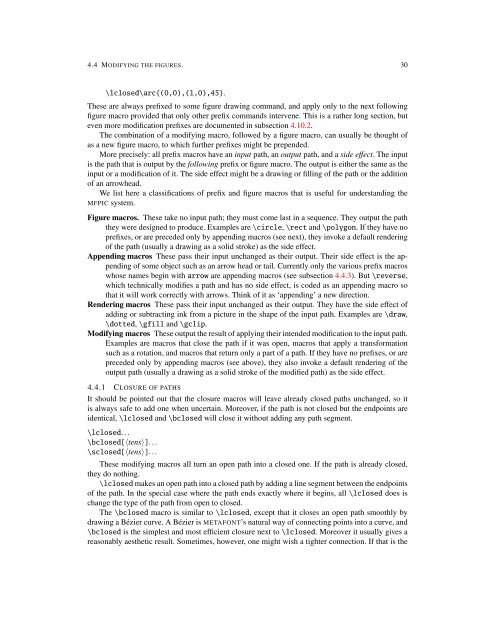You also want an ePaper? Increase the reach of your titles
YUMPU automatically turns print PDFs into web optimized ePapers that Google loves.
4.4 MODIFYING THE FIGURES. 30<br />
\lclosed\arc{(0,0),(1,0),45}.<br />
These are always prefixed to some figure drawing command, and apply only to the next following<br />
figure macro provided that only other prefix commands intervene. This is a rather long section, but<br />
even more modification prefixes are <strong>doc</strong>umented in subsection 4.10.2.<br />
The combination of a modifying macro, followed by a figure macro, can usually be thought of<br />
as a new figure macro, to which further prefixes might be prepended.<br />
More precisely: all prefix macros have an input path, an output path, and a side effect. The input<br />
is the path that is output by the following prefix or figure macro. The output is either the same as the<br />
input or a modification of it. The side effect might be a drawing or filling of the path or the addition<br />
of an arrowhead.<br />
We list here a classifications of prefix and figure macros that is useful for understanding the<br />
MFPIC system.<br />
Figure macros. These take no input path; they must come last in a sequence. They output the path<br />
they were designed to produce. Examples are \circle, \rect and \polygon. If they have no<br />
prefixes, or are preceded only by appending macros (see next), they invoke a default rendering<br />
of the path (usually a drawing as a solid stroke) as the side effect.<br />
Appending macros These pass their input unchanged as their output. Their side effect is the appending<br />
of some object such as an arrow head or tail. Currently only the various prefix macros<br />
whose names begin with arrow are appending macros (see subsection 4.4.3). But \reverse,<br />
which technically modifies a path and has no side effect, is coded as an appending macro so<br />
that it will work correctly with arrows. Think of it as ‘appending’ a new direction.<br />
Rendering macros These pass their input unchanged as their output. They have the side effect of<br />
adding or subtracting ink from a picture in the shape of the input path. Examples are \draw,<br />
\dotted, \gfill and \gclip.<br />
Modifying macros These output the result of applying their intended modification to the input path.<br />
Examples are macros that close the path if it was open, macros that apply a transformation<br />
such as a rotation, and macros that return only a part of a path. If they have no prefixes, or are<br />
preceded only by appending macros (see above), they also invoke a default rendering of the<br />
output path (usually a drawing as a solid stroke of the modified path) as the side effect.<br />
4.4.1 CLOSURE OF PATHS<br />
It should be pointed out that the closure macros will leave already closed paths unchanged, so it<br />
is always safe to add one when uncertain. Moreover, if the path is not closed but the endpoints are<br />
identical, \lclosed and \bclosed will close it without adding any path segment.<br />
\lclosed...<br />
\bclosed[〈tens〉]...<br />
\sclosed[〈tens〉]...<br />
These modifying macros all turn an open path into a closed one. If the path is already closed,<br />
they do nothing.<br />
\lclosed makes an open path into a closed path by adding a line segment between the endpoints<br />
of the path. In the special case where the path ends exactly where it begins, all \lclosed does is<br />
change the type of the path from open to closed.<br />
The \bclosed macro is similar to \lclosed, except that it closes an open path smoothly by<br />
drawing a Bézier curve. A Bézier is METAFONT’s natural way of connecting points into a curve, and<br />
\bclosed is the simplest and most efficient closure next to \lclosed. Moreover it usually gives a<br />
reasonably aesthetic result. Sometimes, however, one might wish a tighter connection. If that is the

















